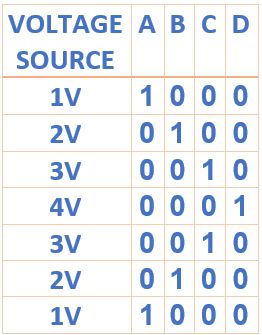Lets say I have 5 leds, lets call them A B C D E.
I have a voltage source that can vary it out from 2-10V for example, now I need a circuit that when the voltage source output 3V (for example), led "A" turns on. now when the voltage source output 4V, led "B" turns on
but led "A" turns off., then when the voltage source output 5V, led "C" turns on
but led B turns off, so only 1 led at the time turns on, so I cant just put a few comparators with the non inverting input sensing the voltage and the inverting input having the threshold voltage because then A and B for example are going to turn on.
0 = off, 1 = on
*under no circumstances I can have 2 LEDs turn on at the same time (for more then a few ms), there has to be ALWAYS at least 1 led on, the circuit has to be that there is no way of 2 LEDs turning on at the same time.